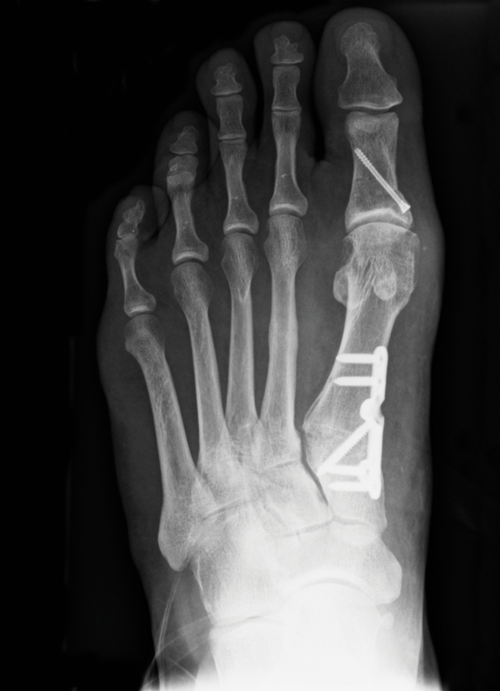
1st Metatarsocuneiform Joint Fusion.
The surgery will be undertaken with local anaesthetic in conjunction with sedation if required
The operation takes about 90 minutes, although you will be in the day surgery unit for longer. You must have a competent adult at home for the rest day and night after surgery. This allows us to be sure you will be safe for the first night. Your operated leg will be non weight-bearing in a cast for approximately 4–6 weeks. It is therefore very important that you have people to look after you.
Aims of Surgery
- To reduce pain and deformity in larger or unstable bunions.
- To straighten the big toe.
Advantages of this Operation
- Stabilises the foot and allows correction of larger deformities.
- Addresses arthritic and painful first metatarsal/cuneiform joints with bunion deformities.
Specific Risks of this Operation
- Joint stiffness.
- Arthritis in other joints.
- Transfer of pressure to the ball of the foot.
- Recurrence of symptoms.
- Damage to nerves, tendons, or blood vessels.
- Delayed or non-union of bone (bone does not knit together).
- Fixation problems (with screws/plates/pins).
- Elevation of the first metatarsal.
- Shortening of the big toe.
- Potential need for further surgery.
- Deep vein thrombosis or pulmonary embolism.
Operation Time
Usually about 60–90 minutes.
Incision Placement/Stitches
Incisions are usually made on the side of the foot, using absorbable stitches where possible.
Procedure
- The bony surfaces on either side of the first metatarso-cuneiform joint (joint at the base of the first metatarsal) are cut away to allow correction.
- The raw bone surfaces are then held together while they fuse (heal together).
- Additionally, an Akin or closing wedge osteotomy (bone cut) of the big toe may be required.
Fixation
- Internal fixation (bone screws, plates, or wires) is usually used.
- These are typically not noticeable and do not usually need to be removed (<20%).
Will I Have Plaster?
Yes, usually for about 4 weeks. You will need crutches for about 4 weeks, then a cam walker for a further 2–4 weeks.
Is This a Day Procedure?
Yes, you will go home the same day.
Estimated Time Off Work
- Non-manual work: approximately 4 weeks.
- Manual work: approximately 8–10 weeks.
Alternative Treatments
Manage symptoms by altering activity levels, using painkillers and anti-inflammatories, changing footwear (including bespoke options), joint injection therapy, and using an insole or orthotic foot support (note that insoles, orthoses, or toe splints have not been shown to correct toe deformity).
Post-Operative Care
First 2–4 days after surgery
- This is the time you are likely to have the most pain, but you will be given painkillers to help. You must rest completely for 2–4 days.
- You will have a below knee cast and cannot put weight on the operated foot.
- You will be able to stand and take weight on your non-operated foot after the operation, but you must rest with your feet up, as much as possible.
- You should restrict your walking to going to the bathroom. When getting about, use your crutches in the way you will have been shown.
- You can get about a little more after 3 days.
1 week after surgery
- You will need to attend for your foot to be checked and, if necessary, redressed/recasted.
Between 4–6 weeks after surgery
- The cast will be removed if all is proceeding well and you will be allowed to start walking in a cam walker.
Between 8–10 weeks after surgery
- If all has gone well you will be able to start wearing a good lace-up shoe/trainer.
- The foot will still be swollen and twinges of discomfort are not uncommon at this time due to your increasing activity. Your leg will feel naturally weak to start with as it has been in a cast.
- You will be instructed regarding rehabilitation exercises or you may be referred to a physiotherapist.
- You may return to non-manual work but may need longer if you have an active job.
- You may return to driving if you can perform an emergency stop. You must check with your insurance company and Mr. Cichero before driving again.
Between 12–16 weeks after surgery
- The foot should continue to improve and begin to feel normal again.
- There will be less swelling.
- Sport can be considered depending on your recovery.
6 months after surgery
- You will have the final review between 3–6 months following surgery.
- The swelling should now be slight and you should be getting the full bene t of the surgery.
12 months after surgery
- The foot has stopped improving with all healing complete.
Please note, if a complication arises, recovery may be delayed.
Start your healthcare journey
For more information, questions or queries, please email us or call 01872 392087.

